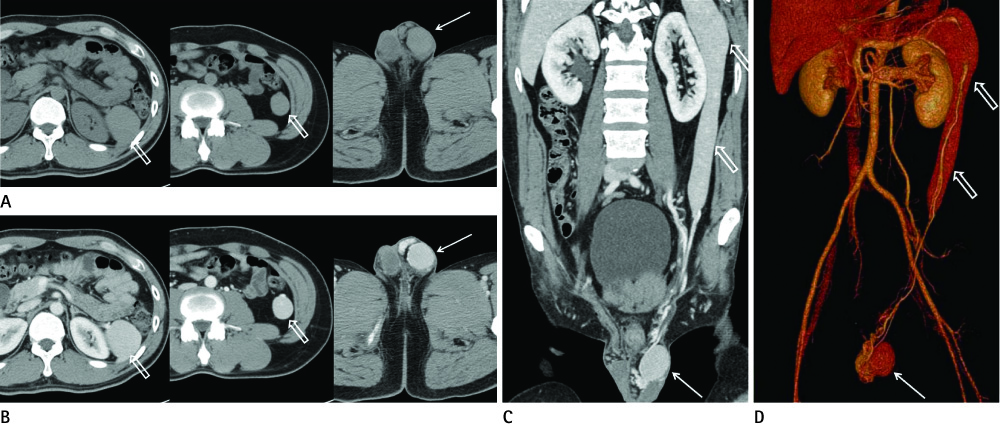J Korean Soc Radiol.
2011 Dec;65(6):589-593. 10.3348/jksr.2011.65.6.589.
Splenogonadal Fusion: A Case Report
- Affiliations
-
- 1Department of Radiology, Wonju Christian Hospital, Yonsei University Wonju College of Medicine, Wonju, Korea. wckwon@yonsei.ac.kr
- KMID: 2002927
- DOI: http://doi.org/10.3348/jksr.2011.65.6.589
Abstract
- Splenogonadal fusion is a rare congenital anomaly characaterized as the fusion of the spleen and a gonad. The first report of this anomaly was in 1883 and only 160 cases have been reported to date. As far as we know, this is the first reported case of splenogonadal fusion in this country.
MeSH Terms
Figure
Reference
-
1. Ando S, Shimazui T, Hattori K, Yamamoto T, Kuriyagawa K, Akaza H. Splenogonadal fusion: case report and review of published works. Int J Urol. 2006; 13:1539–1541.2. Alvarez Maestro M, López-Tello J, Domínguez Franjo P, Ríos González E, Martínez-Piñeiro L. [Splenogonadal fusion. Report of a case and review of the literature]. Actas Urol Esp. 2010; 34:293–295.3. Boestrom E. Demonstration eines praparates von verwachsung der milz mit dem linken hoden. Gellschaft deutscher Naturforscher und Artze Verhandlungen der 56 Versammlung. Freiburg. 1883; 149.4. Putschar WG, Manion WC. Splenicgonadal fusion. Am J Pathol. 1956; 32:15–33.5. Carragher AM. One hundred years of splenogonadal fusion. Urology. 1990; 35:471–475.6. Duncan WL Jr, Barraza MA. Splenogonadal fusion: a case report and review of literature. J Pediatr Surg. 2005; 40:e5–e7.7. Hizli F, Uygur MC, Irkkan C. Splenogonadal fusion: report of a case. Int J Urol. 2005; 12:591–592.8. Sneath WA. An apparent third testicle consisting of a scrotal spleen. J Anat Physiol. 1913; 47:340–342.9. Steinmetz AP, Rappaport A, Nikolov G, Priel IE, Chamovitz DL, Dolev E. Splenogonadal fusion diagnosed by spleen scintigraphy. J Nucl Med. 1997; 38:1153–1155.
- Full Text Links
- Actions
-
Cited
- CITED
-
- Close
- Share
- Similar articles
-
- Intertransverse Fusion in Spondylolisthesis: Report of a Case
- Repeated Migration of a Fusion Cage after Posterior Lumbar Interbody Fusion
- Sacral Stress Fracture Developing after Lumbosacral Fusion in a Patient with Spondylolisthesis: A Case Report
- The Treatment of Spondylolysis with Anterior Spinal Fusion: A Report of Three Cases
- Severe Retrolisthesis at the Adjacent Segment after Lumbar Fusion Combined with Dynamic Stabilization





